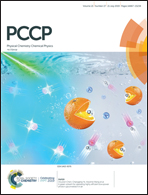Analytic theory of finite-size effects in supercell modeling of charged interfaces
Abstract
The Ewald3D sum with the tinfoil boundary condition (e3dtf) evaluates the electrostatic energy of a finite unit cell inside an infinitely periodic supercell. Although it has been used as a de facto standard treatment of electrostatics for simulations of extended polar or charged interfaces, the finite-size effect on simulated properties has yet to be fully understood. There is, however, an intuitive way to quantify the average effect arising from the difference between the e3dtf and Coulomb potentials on the response of mobile charges to contact surfaces with fixed charges and/or to an applied external electric field. Although any charged interface formed by mobile countercharges that compensate the fixed charges fluctuates upon a change in the acting electric field, the distance between a pair of oppositely charged interfaces is found to be nearly stationary, which allows an analytic finite-size correction to the amount of countercharges. Application of the theory to solvated electric double layers (insulator/electrolyte interfaces) predicts that the state of complete charge compensation is invariant with respect to solvent permittivities, which is confirmed by a proper analysis of simulation data in the literature.



 Please wait while we load your content...
Please wait while we load your content...